| HOME | PROFILE | SERVICES | MEETINGS & INCENTIVES | TRANSPORT | TOURS | PACKAGES | STUDENTS | CONTACT US |
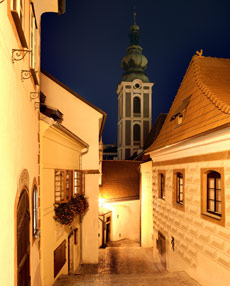
GERMANY
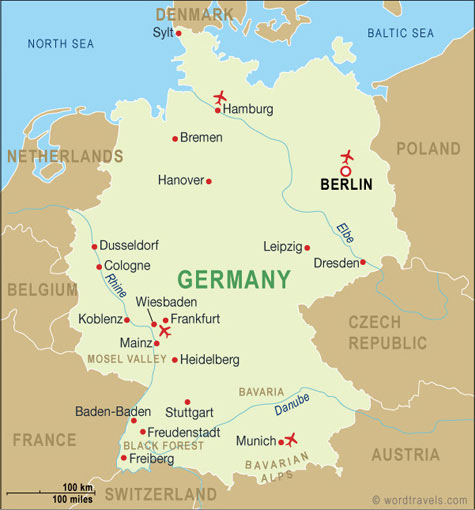
As Germany moves forward into the 21st century, leaving behind a history of division and tyranny, it is a nation embracing its newfound liberalism and redefining a modern cultural identity. Yet even today, visitors to the country can't escape feeling profoundly moved by this country's past and the effects it still has on its people.
Situated in the heart of Europe and bordering nine other countries, Germany provides an ideal gateway to any tour of the subcontinent. Its land is wide and varied with turreted castles nestled below snow-capped mountains, lush river valleys, dark and mysterious forests and bustling medieval villages. This is the land of fairy tales, where farmland minstrels headed to Bremen to become musicians, where Sleeping Beauty was woken and Little Red Riding Hood ventured into the woods.
Germany's cities each have something unique to offer the visitor. Each year millions of litres of beer are consumed in Munich during the city's Oktoberfest, where locals and visitors discover true German revelry and 'gemutlichkeit' (a word the locals use to describe a comfortable, sociable environment). Berlin, while still recovering from some of the scars of division, contains many sights from the iconic Brandenburg Gate, to the path of the old Berlin Wall. The city's vibrant nightlife is still evocative of its height in the 1920s and 30s, as characterised by the songs of Marlene Dietrich, the theatre of Brecht and the Film Cabaret.
Discover the country that gave us Beethoven and Bauhaus, Goethe and Glühwein, Lager and Lederhosen - you won't be disappointed.
Germany Attractions
Germany remains one of the worlds leading sightseeing destinations by virtue of its unique and important historical attractions, charming medieval buildings, varied, beautiful landscape, and legendary cultural events. The country has played a leading role in world history and many of its attractions - varying from celebrated to infamous - are connected to this picaresque legacy.
The major cities such Berlin, Munich and Frankfurt are attractions unto themselves, each jam-packed with historical treasures and sites of interest. Dachau and Checkpoint Charlie point to more troubled periods, while the magnificent Rhineland and Garmisch-Partenkirchen region offer natural splendour to please the most demanding outdoors enthusiast. Munich is home to one of the worlds biggest parties, the legendary Oktoberfest, while the Romantic Road between Berlin and Frankfurt is a self-drive tourist classic that never fails to disappoint with its perfectly preserved towns and villages.
Germany is certainly a year-round destination although be warned the European winters (December to February) can get very cold. The best way to travel around the country is by train as the network is comprehensive, very reliable and safe, and decent value for money. Another good option is to rent a car and drive between attractions as fast as you like on the Autobahn.
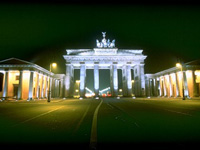 Brandenburg Gate
Brandenburg Gate
The impressive and symbolic Brandenburg Gate that lay forlorn for so long in the no man's land behind the Berlin Wall, is now once again renovated and accessible, along with the newly reconstructed Pariser Platz that links the gate to the beautiful Unter den Linden Boulevard. The gate is Berlin's only remaining city gate, built of sandstone between 1788 and 1791 with 12 Doric columns according to a design by C.G. Langhans. Six columns support a 36-foot (11m) transverse beam, similar to the propylaeum of the Acropolis in Athens. The massive gate is topped with a stunning statue of the Goddess of Victory facing east towards the city centre (this was added in 1794). The gate is closed to traffic, as is the adjacent Pariser Platz, a gracious square that was once surrounded with beautiful buildings sadly destroyed in the Second World War. Since the fall of the Berlin Wall new buildings have been built, however, to designs closely following those of the originals.
 Checkpoint Charlie
Checkpoint Charlie
The infamous border crossing point in the wall dividing West and East Berlin has now become a shrine to the wall's memory with the addition of a museum, Haus am Checkpoint Charlie. For nearly 30 years, between 1961 and 1990, Checkpoint Charlie in the Friedrichstrasse was the only crossing point between East and West Berlin. The soldier's post can be visited, and tourists can be photographed under the border sign.
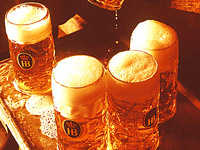 Hofbrauhaus
Hofbrauhaus
Beer has been swilled at this world-famous tavern site in the centre of Munich since it became a royal brewery in 1605. Equally famous is the Bavarian jollity and conviviality, known as 'gemuchtlikheid', which has emanated directly from the Hofbrauhaus in Munich along with the beer which flows freely there each day, served by robust rosy-cheeked young women clad in Bavarian dress in litre-sized beer steins. The cheerful atmosphere that reigns constantly in the establishment's different halls is helped along by the foot-tapping strains of traditional Bavarian 'oom-pah' bands and drinking songs. When the beer becomes too much, soak it up with a delicious salty pretzel or a German speciality from the menu, such as liver dumplings, potato soup or a variety of delicious sausages.
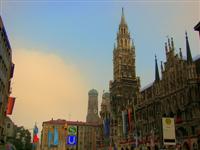 Marienplatz
Marienplatz
The Marienplatz is the heart of Munich and the site of its most important historic buildings. The square is dominated by the Neo-Gothic Town Hall featuring its famous Glockenspiel, both built in the 19th century. The Glockenspiel delights visitors when it chimes the hours every day at 11am, 12pm and 5pm with its 43 bells, accompanied by moving clockwork figures that display vignettes from Munich's history. The Town Hall has a tower that can be accessed by a lift. The centre of the square - which was once a vibrant farmer's market - features a statue of the Virgin Mary after which Marienplatz was named. Visitors can also explore a toy museum in the Old Town Hall on the square, and the Frauenkirche, Munich's cathedral, dating from the 15th century.
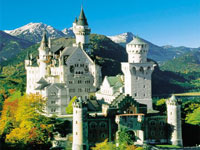 Neuschwanstein
Neuschwanstein
The fairytale castle built by King Ludwig II (known as 'Mad King Ludwig' until his death in 1886) has become the trademark of the German state of Bavaria, with its Gothic wedding-cake tiers and towers. Day tours to the castle are available from Munich, or self drive via Garmisch. From the parking lot there is a steep half-mile (one km) climb to the castle, but one can ride in a horse-drawn carriage. The interior of the castle is as extravagant as its outer aspect, particularly the King’s apartments, which are decorated entirely with hand-embroidered silk, elaborate wall and ceiling paintings, and carvings.
 Dachau Memorial Site
Dachau Memorial Site
About 10 miles (16km) to the northwest of Munich on the Stuttgart Autobahn is the town of Dachau, once a quiet artists' community that became the site of the first notorious Nazi 'death camp', where thousands of perceived enemies of the Third Reich were imprisoned, starved, and killed between 1933 and 1945. The camp has now been turned into a memorial museum to the prisoners (67,000 were liberated alive by the US Army on April 28, 1945). The museum contains three memorial chapels. The Lagerstrasse, the main camp road, still exists lined with poplar trees but only two of the original 32 barracks that lined it remain, having been rebuilt to illustrate the conditions endured by the prisoners. The original kitchen, laundry and shower block is now a museum containing exhibits, photographs and documents depicting the persecution of Jews and other prisoners.
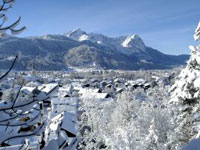 Garmisch-Partenkirchen
Garmisch-Partenkirchen
Germany's top winter sports destination, Garmisch-Partenkirchen is a busy centre that has retained the charm of the older town of the twins, Partenkirchen. About 20 trains a day arrive at the Garmisch-Partenkirchen Bahnhof from Munich, and many more visitors come by bus or self-drive via the A95 Autobahn to enjoy the delights of the Bavarian Alps. Pride of the city is the Olympic Ice Stadium and the larger Ski Stadium which were built for the 1936 Winter Olympics and are still put to good use by winter sports enthusiasts. The area is picturesque and scenic, both in winter and summer. In summertime it is a popular spot for hiking and mountain climbing expeditions. A tourist office assists visitors in making the most of their visit and seeing the local attractions.
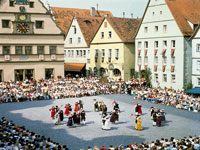 Romantic Road
Romantic Road
To experience the best of medieval Germany hundreds of visitors drive, bus or cycle their way along the Romantic Road, a 180-mile (290km) route between Munich and Frankfurt that links together a string of quaint, well-preserved walled towns dating back a thousand years or more. The towns en route have banded together to market their attractions and ensure Romantic Road travellers are well informed and accommodated. Bicycles can be rented at any train station along the road, and tourist offices along the route provide maps and information. Best known of the towns on the Romantic Road is Rothenburg in the Tauber River Valley. Other favourites among the cute towns are Dinkelsbuhl and Nordlingen.
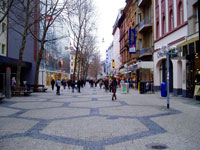 Wiesbaden
Wiesbaden
Germany's most favoured spa resort lies about 25 miles (40km) west of Frankfurt in a valley between the Rhine River and Taunus Mountains. The town has been a spa resort since the time of the ancient Romans, with its 26 hot springs averaging temperatures of around 50°C (122°F). Besides being known for its luxurious spa hotels, Wiesbaden is also a cultural centre, its events being concentrated around the major Kurhaus concert hall complex. The complex includes a casino and restaurant, conference and exhibition facilities.
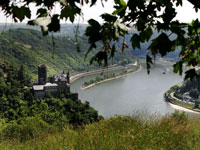 The Rhineland
The Rhineland
The wide, deep and sluggish Rhine River flows from Switzerland into the sea in the Netherlands, and most of its length in the process meanders through the mountains and plains of Germany. The river has always served as a major trading route, and it is also a favourite with tourists who enjoy cruising it, particularly along its scenic mid-section between Mainz and Koblenz. Boarding a steamer in Mainz, about 25 miles (40km) south west of Frankfurt, one journeys through steep vine-covered hillsides dotted with romantic towns and castles, many associated with fascinating legends and fables.
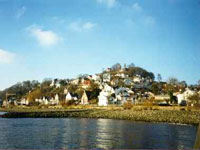 Blankenese
Blankenese
This quaint destination on the steep Elbe hillside was once a fishing village favoured by retired ship captains. Today it has become popular with locals as a weekend outing, and visitors also throng the narrow alleys and stairways between picturesque houses packed together on the cliffside. The village offers an abundance of cafes and restaurants where patrons can relax and watch ships steaming in and out of the harbour. There is a ferry service to Blankenese from St Pauli-Landungsbrucken in Hamburg's Free Port.
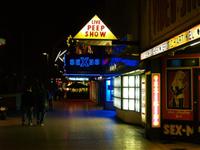 Reeperbahn
Reeperbahn
Hamburg's notorious red light district to the east of the city centre in the St Pauli zone has become its second-greatest tourist attraction, according to the city management. The Reeperbahn (Rope Street) is where rope used to be produced for the ships in the harbour. It is now a half-mile long street which, along with its cross-streets, is filled with bright lights and flirtatious prostitutes, crammed with bars and establishments offering erotic entertainment. The Reeperbahn became the neighbourhood where sailors of old were encouraged to seek entertainment after they were banned from invading the city's more respectable areas in the 19th century. The district also boasts an Erotic Art Museum (at Nobistor 10A), which is privately owned and restricted to persons over 16.
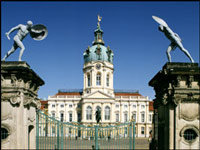 Charlottenburg Palace
Charlottenburg Palace
Schloss Charlottenburg is the largest palace in Berlin, an 18th-century baroque structure that was originally constructed as the summer home for Sophie Charlotte, the wife of Elector Frederick III who became the first Prussian king. The splendid interiors are festooned with art masterpieces, while the surrounding gardens contain a mausoleum, pavilion and the Belvedere, which houses the porcelain museum.
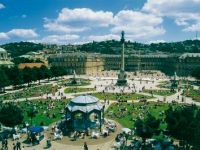 Palace Square (Schlossplatz)
Palace Square (Schlossplatz)
The symbolic heart of Stuttgart, the Schlossplatz or Palace Square, is a popular meeting point for locals and travellers alike, the beautifully baroque New Palace providing a majestic backdrop. The former residence of kings, the New Palace was built between 1746 and 1806 and is now a base for the state government of Baden- Wurttemberg. If the New Palace feels a bit French it's because the Duke Carl Eugen of Wurttemberg wanted to create a Versailles in Stuttgart. The König Wilhelm Jubilee Column, rising in the fore, was erected in 1841 in honour of King Wilhelm's silver jubilee (25 years of reign), and the statue of Concordia, the Roman goddess of harmony at the pinnacle, added in 1863. The two fountains were built at the same time, the eight cherubs each representing one of Württemberg's rivers.
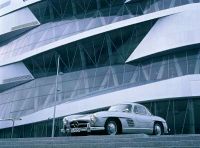 Mercedes-Benz Museum
Mercedes-Benz Museum
Opened shortly before the start of the Football World Cup in Germany, the impressive Mercedes-Benz Museum is housed in a slick, contemporary building, an icon of modern architecture. With an exhibition space of almost 182,986 ft² (17,000 m²) covering seven storeys, the museum takes visitors on a chronological journey through the history of the Mercedes automobile. Combining world events occurring at the same time as Benz breakthroughs and displaying over 160 different vehicles from racing cars and concept cars to the pope mobile and airplane engines, there is much for the automobile aficionado to see.
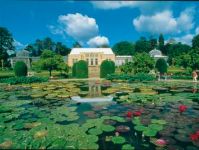 Wilhelma Zoo
Wilhelma Zoo
Europe's only combined zoological and botanical garden, the Wilhelma Zoo never fails to leave a lasting impression on the hearts and minds of all who explore her confines. Initially built as a Moorish garden for King Wilhelm 1 in the 19th century, the beautiful botanical garden is extraordinary all year round. Countless exotic plants, a range of climatic biospheres in magnificent greenhouses, a petting zoo, insect exhibit, aquarium with crocodile hall, modern ape house, bear facilities, walk-in bird flight facility and wild animal enclosures are some of the exhilarhating sights to be enjoyed. Ideal for children and adults, there are a host of ice cream stands, cafeterias and playgrounds to keep the whole family entertained for the entire day. The Wilhema Zoo is home to 8,000 animals, including polar bears and elephants, and 5,000 different species of plants.
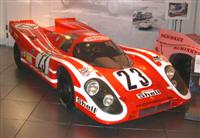 Porsche Museum
Porsche Museum
Just like their cars, the 'small but good' Porsche Museum in Stuttgart is a retrospective of more than 75 years of Porsche engineering and memorabilia. The 20 or so exhibits from the first Porsche-branded car to series cars and the Formula 1 champions of the mid 1980s; the various Porsche models are switched several times a year. Following in the footsteps of other automobile titans, the Porsche Museum is turning over a new leaf with construction on a 60,277 square feet (5,600 square meters) architectural landmark to house some of its 300 strong collection. The new museum will be inaugurated toward the end of 2008, boasting the latest in automobile exhibition technology and quadrupling the number of pristine Porsches on display.
Germany Events
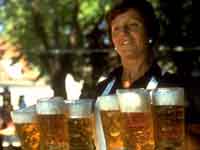
Oktoberfest
Date: 19 September to 4 October 2009
At the end of September/beginning of October each year all roads in Munich lead to the Theresienwiese, a giant grass meadow about the size of 20 football fields near the centre of the city. The occasion is the world's biggest party, the Munich Oktoberfest. The field becomes a beer-drinking city, complete with its own post office, police force and fire department, and most importantly numerous huge tents, erected by the various Bavarian breweries, that serve as massive beer halls. The first keg is tapped in ceremonial style to open the two-week celebration, which draws hundreds of thousands of revellers from all around the world. Apart from the rollicking beer halls where traditional Bavarian bands belt out their old favourites, the festival offers a host of carnival games and fun park rides, as well as stalls selling a range of German delicacies.
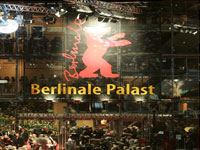
Berlin International Film Festival
Venue: Potsdamer Platz
Date: 11 - 21 February 2010
The coveted Silver and Golden Bears of the Berlin International Film Festival are the symbol of achievement in one of the top events in the film industry. The Berlinale has become one of the biggest and most reputable festivals in the international business of artistic media and film, where world-class filmmakers launch their latest achievements under various categories in the competition. Film screenings are shown in a variety of festival cinemas, and different events include filmmaking workshops, and opportunities for young producers and directors to screen one-minute films during the festival.
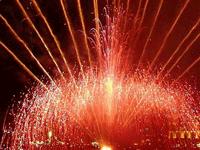
Alster Fair
Venue: Around the Inner Alster Lake
Date: August 2009 TBA
One of the city's biggest annual summer festivals, the Alster Fair is a celebration of food and drink, music, theatre, sporting events, handicrafts and numerous fringe events that provide entertainment for all ages. Part of the fair is the International Fireworks Festival that presents spectacular nightly fireworks displays.

Christmas Markets
Venue: Various
Date: 26 November to 31 December 2008
During the festive season more than 40 Christmas markets around the city attract visitors with typical arts and crafts, Christmas lights and decorations, and the smell of Glühwein, gingerbread and roasted nuts. Santa Claus, music and dance, fairy tales and puppetry are there to entertain the children while shoppers can browse past antique toys and doll makers, candles, woodcarvers, and a variety of traditional goods. The largest Christmas market in Europe is said to be in the suburb of Spandau, where the stalls are spread out throughout the Old Town and provide a particularly traditional experience.
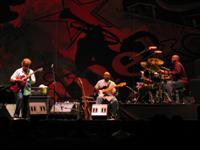
JazzFest Berlin
Venue: Various
Date: 5 – 9 November 2008
The Berlin Jazz Festival is one of the world's premier jazz festivals and the highlight on the Berlin musical calendar, with concerts taking place all over town. Some of the biggest names in the business are attracted to this annual event, with big American names like Herbie Hancock and Lee Konitz, but world music bands also feature on the programme.
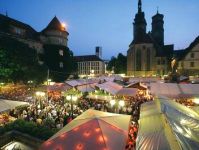
Stuttgart Wine Village Festival
Venue: Marktplatz, Schillerplatz and Kiurchstrabe
Date: August to 6 September 2009
Wine lovers should head to Stuttgart in the Baden-Wurttemberg region in Germany during fall for the annual Stuttgart Wine Village Festival. Celebrating local wine since 1974, Stuttgart is transformed into a festive village during the beginning of September with 120 wine stalls smattered across the market square, Schillerplatz and Kiurchstrabe. Pouring over 250 unique local wines from Riesling and Trollinger to Müller-Thurgau and Ruländer, the heart of Swabian culture can be found here. Festival goers can enjoy the animated dancing, singing and merrymaking, not to mention the mouth-watering Swabian specialities and other culinary delicacies.
Public Holidays
2009 |
2010 |
|
New Year's Day |
1 Jan |
1 Jan |
Epiphany |
6 Jan |
6 Jan |
WWII Genocide Memorial Day |
27 Jan |
27 Jan |
Good Friday |
10 Apr |
2 Apr |
Easter Sunday |
12 Apr |
4 Apr |
Easter Monday |
13 Apr |
5 Apr |
Kindergarten Day |
21 Apr |
21 Apr |
Walpurgisnacht (Witches' Night) |
30 Apr |
30 Apr |
Labour Day |
1 May |
1 May |
Ascension Day |
21 May |
13 May |
Whit Monday |
1 Jun |
24 May |
Corpus Christi |
11 Jun |
3 Jun |
Assumption of the Virgin Mary |
15 Aug |
15 Aug |
Day of German Unity |
3 Oct |
3 Oct |
Day of Reformation |
31 Oct |
31 Oct |
All Saints' Day |
1 Nov |
1 Nov |
Berlin Wall Opening Day |
9 Nov |
9 Nov |
National Day of Mourning |
14 Nov |
14 Nov |
Repentance Day |
18 Nov |
17 Nov |
St Nicholas' Day |
6 Dec |
6 Dec |
Christmas Day |
25 Dec |
25 Dec |
2nd day of Christmas |
26 Dec |
26 Dec |
Airport
Berlin-Tegel Airport (TXL)
Location: The airport is situated five miles (8km) north west of the centre of Berlin.
Time: GMT +1 (GMT +2 between the last Sunday in March and the Saturday before the last Sunday in April).
Contacts: Tel: +49 180 50 00 186.
Getting to the city: The most convenient and cost effective way to get to and from the airport is by bus. They connect with the subway and overground train stations. Taxis are readily available outside the airport terminals on both levels and cost around €15. The journey to Berlin takes around 20 minutes.
Car rental: Vehicle hire companies represented at the airport include Budget, Avis, Hertz, Europcar, National and Sixt.
Airport Taxis: Taxis are readily available outside the Berlin-Tegel Airport’s Terminal A1. A taxi to the centre of Berlin takes approximately 20 minutes and costs between €35 and €40. Avoid touts and unlicensed taxis. Private hotel shuttle services to and from Berlin-Tegel Airport are also available.
Facilities: Facilities include banks, bureaux de change, ATMs, a post office, business centres and baby rooms. There are several shops, including duty-free, and a selection of restaurants. Disabled facilities are good; travellers with special needs should contact their airline in advance.
Parking: There are several long and short-term parking lots at the airport.
Departure Tax: None.
Frankfurt Airport (FRA)
Location: The airport is situated eight miles (13km) south west of the centre of Frankfurt.
Time: GMT +1 (GMT +2 between the last Sunday in March and the Saturday before the last Sunday in April).
Contacts: Tel: +49 (0)69 6900.
Transfer between terminals: The two terminals are connected by the Sky Line people mover.
Getting to the city: Frankfurt Airport has trains from two railway stations; the long-distance railway station is at the AIRail Terminal, and there is a local railway station for S-Bahn, regional and local trains at Terminal 1, Level 1. Both railway stations are linked to Terminal 2 via buses and the Sky Line. Buses leave regularly for Frankfurt and other destinations from outside Terminals 1 and 2, tickets can be bought from the bus driver. Airline shuttles, including Lufthansa Airport Shuttle and Hahn Airport shuttle, depart from Terminal 1 outside Arrival Hall B. Taxis are available outside both terminals, the journey to central Frankfurt takes 20-30 minutes. Car hire companies are represented in both terminals.
Car rental: Car hire companies represented in both terminals at the airport include Avis, Budget, Europcar, Hertz and Sixt.
Airport Taxis: From Franfurt Airport taxis can be found outside either terminal and will take 20-30 minutes for the 8-mile (13km) drive to the city centre. Taxis are metered and prices are around €24 into town. Be careful of taxi drivers taking longer routes to increase the fare.
Facilities: Frankfurt Airport is one of the best-equipped airports in the world; it even offers a casino. There are numerous restaurants, shops, bars and cafes in both terminals, and banks, bureaux de change and ATMs are in both Arrivals and Departures. A business centre offers Internet, fax and secretarial facilities. Other facilities include a hairdresser, chapel and children's play areas. Disabled facilities are good; travellers with special needs should ideally contact their airline in advance.
Departure Tax: None.
Hamburg Airport (HAM)
Location: The airport is situated five miles (8km) from Hamburg.
Time: GMT +1 (GMT +2 between the last Sunday in March and the Saturday before the last Sunday in April).
Contacts: Tel: +49 (0)40 5075-0.
Getting to the city: The Airport Express runs frequent buses to the Central Station (Hauptbahnhof). The TRAVELPorter Airport transfer service provides a door-to-door service within the local area. Hamburg Bus Lines service the city centre and other suburban areas. Taxis are readily available outside all terminals, they take around 30 minutes to the city centre.
Car rental: Avis, Europcar, Hertz, Budget, National and Sixt are all represented in Terminal 2.
Facilities: There are several restaurants, shops, bars and cafes throughout the airport, as well as banks, currency exchange and ATMs in Terminals 1 and 2. There is wireless Internet access in all terminals. Disabled facilities are good; passengers with special needs should contact their airline in advance.
Departure Tax: None.
Munich International Airport (MUC)
Location: The airport is situated 18 miles (29km) north east of the centre of Munich.
Time: GMT +1 (GMT +2 between the last Sunday in March and the Saturday before the last Sunday in April).
Contacts: Tel: +49 (0)89 975 00. Flight Information: +49 (0)89 975 213 13.
Getting to the city: Frequent commuter trains run by day and most of the night to various Munich stations, including the main stations for connections to major European cities. Taxis are available, as are buses to many regional destinations and the main train station. It takes about 20 minutes by train and about 45 minutes by road to reach the city centre.
Car rental: Car hire companies represented include Avis, Europcar, Hertz, National and Sixt.
Airport Taxis: Taxis are available, as are buses to many regional destinations and the main train station. IsarFunk Taxizentrale operates services form Minuch airport. Tel: (089) 45 0540. The journey time to the city centre is approximately 45 minutes and costs around €35 to €55.
Facilities: The airport has several restaurants and bars, duty free and other shops, shower facilities and a pharmacy. ATMs and currency exchange desks are available in Arrivals and Departures. Disabled facilities are good; passengers with special needs should contact their airline in advance.
Departure Tax: None.
Dusseldorf International Airport (DUS)
Location: The airport is situated six miles (10km) north of Dusseldorf.
Time: GMT +1 (GMT +2 from March to October).
Contacts: Tel: +49 211 4210.
Getting to the city: There are plenty of transport options available at the airport, including taxis (which will cost around €20 to the city centre), limousines, local buses, a Skytrain Shuttle Bus, and the fast and efficient S-Bahn.
Car rental: Car rental companies at the airport include Alamo, Europcar, Hertz, National and Avis, among others.
Facilities: Facilities at the airport include ATMs, banks, a laundry, dental practice, restaurants, cafés, snack-bars, Wireless Internet access and baby-changing facilities.
Parking: Long and short-term, as well as valet parking, is available.
Departure Tax: None.
Cologne-Bonn Airport (CGN)
Location: The airport is located eight miles (12km) southeast of Cologne and 10 miles (16km) north of Bonn.
Time: GMT +1 (GMT +2 from March to October).
Contacts: Tel: +49 (0)22 0340 4001.
Transfer between terminals: The two terminals are linked by a walkway.
Getting to the city: There are several transport options available, including taxis (which cost around €30 to Cologne and around €40 to Bonn), the local bus service, and the S-bahn.
Car rental: Car rental agencies at the airport include Budget, National, Hertz, Avis and Alamo, among others.
Facilities: Facilities at the airport include ATMs, left luggage, a dry cleaning service, shops and restaurants.
Parking: Long and short-term parking is available.
Departure Tax: None.
Stuttgart International Airport (STR)
Location: The airport is located 8 miles (13 km) south of Stuttgart city centre.
Time: GMT +1 (GMT +2 between the last Sunday in March and the last Sunday in October).
Contacts: 805 948 444.
Getting to the city: The airport is connected to central Stuttgart by commuter trains, both serving Stuttgart central station. There are several direct bus links to destinations in and around Stuttgart, as well as a 24-hour taxi service, both departing from outside Terminal 1.
Car rental: Car hire companies include Avis, Budget, Europcar, Hertz, National and Sixt.
Facilities: Facilities at the airport include two banks, ATMs and bureaux de changes. There are restaurants, bars and fast food outlets, a variety of shops, including duty free shops and wireless Internet access available throughout the terminal building.
Departure Tax: None.
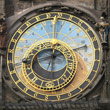
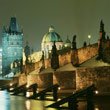
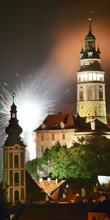
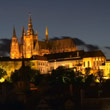
TRAVEL INFO |
|
©2006-2007 Rener Group. All rights reserved |
||
